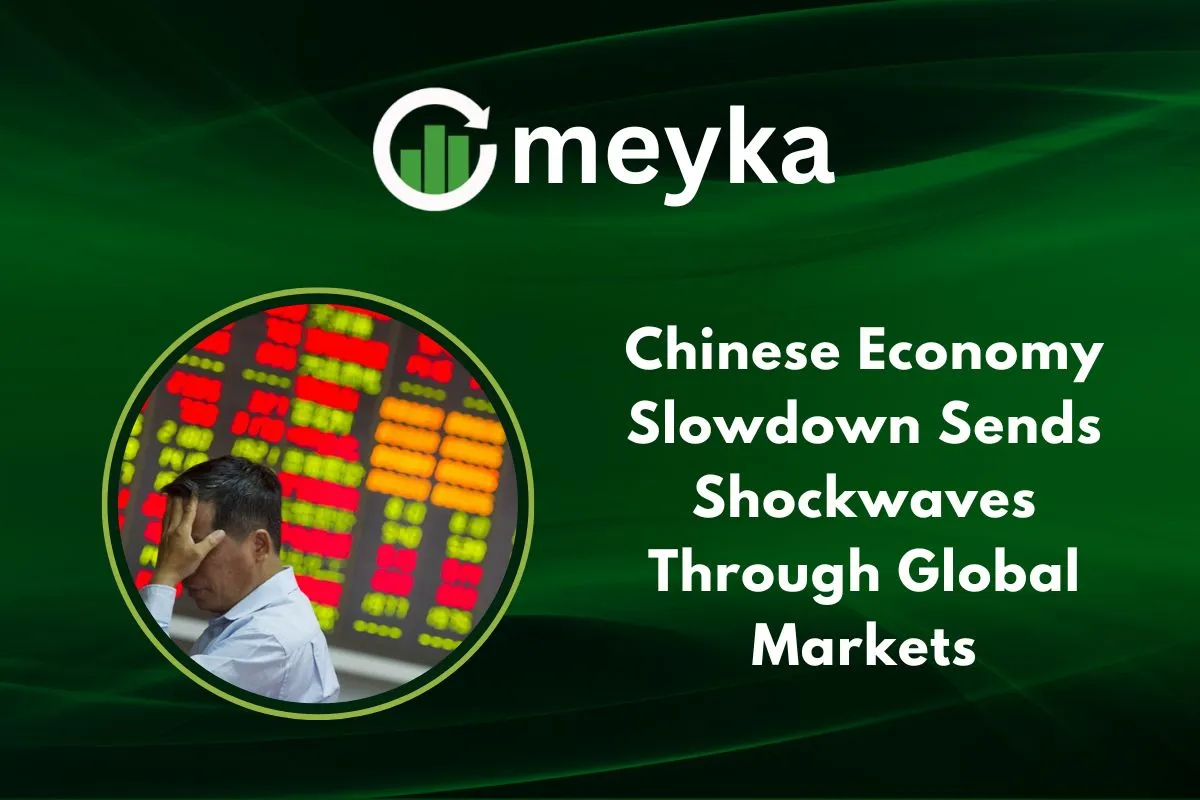Chinese Economy Slowdown Sends Shockwaves Through Global Markets
We are watching the role of the Chinese economy shift in real time. For decades, the Chinese economy powered global growth. It built factories, sold goods worldwide, and lifted millions into the middle class. Now, the speed is slowing. In the third quarter of 2025, China’s GDP grew by just 4.8% year‑on‑year, its weakest pace in a year. When the second‑largest economy in the world goes off track, markets everywhere feel the impact. We’ll explain what’s driving this slowdown, how it’s affecting global markets, and what might come next.
Current Economic Indicators
Let’s take a look at the hard numbers behind the headline of a slowing Chinese economy.
- In Q3 2025, GDP growth hit 4.8% YoY, down from 5.2% in the previous quarter.
- Industrial production rose 6.5% YoY in September bu,, but that rise masked deeper trouble.
- Retail sales grew only about 3.0% YoY in September, while investment in the property sector plunged ~13.9% in the first three quarters.
- In October, factory output and retail sales growth hit their weakest pace in over a year: e.g., industrial output 4.9% YoY, retail 2.9%.
- Fixed asset investment declined 1.7% YoY in October, the worst investment drop since the pandemic.
Together, these numbers show a Chinese economy still growing, but losing momentum. Weakness in consumption and investment is offset only modestly by external demand.
Causes of the Slowdown
What’s behind the slowing pace of the Chinese economy? There are several causes, domestic and global.
Domestic factors
- Consumer confidence is weak. Many households fear job cuts, and the slump in home prices hurts their sense of wealth.
- The property sector is in a crisis. New home prices are falling, developers are strapped for funds, and this drags local government revenue.
- China’s population is aging, and labour force growth is slowing. That limits future growth potential.
- Heavy debt and high infrastructure‑led investment in the past may now be feeding diminishing returns.
Global factors
- Demand for Chinese exports is under pressure. Trade tensions with the United States, shifting global supply chains, and rising costs hurt the export boost.
- The global economy itself is decelerating. Slower growth in many regions means less demand for Chinese‑made goods.
In short: t,, Chinese economy is entering a phase of structural change, not just a cyclical pause.
Impact on Global Markets
Because China plays such a big role in world trade and production, its slowdown sends ripples everywhere.
- Stock Markets: Equity markets in Asia, Europe, and the U.S. react quickly when China’s indicators wobble. Uncertainty about China means investors become more cautious.
- Commodity Prices: China is a huge consumer of commodities (oil, copper, and iron ore). Weak Chinese demand can cause prices to slide globally.
- Currency Fluctuations: If the Chinese yuan weakens or export volumes shrink, trade imbalances shift an,d other currencies feel the strain.
- Supply Chains: Many global supply chains depend on Chinese manufacturing. Slowdowns in factories or disruptions in exports can delay goods worldwide.
- Investor Sentiment: China’s softness feeds into global risk‑appetite. If one large economy falters, investors may pull back from more exposed markets.
Thus, the effect is not isolated to China; the world is connected.
Specific Sectoral Impacts
Let’s zoom into one of the sectors where China’s slowdown is felt most strongly.
- Technology & manufacturing: While high‑tech manufacturing (like electronics) still grew, many segments tied to property or heavy investment performed poorly. For example, hi‑tech manufacturing rose ~10.3% in Sept, but cement and steel production declined.
- Automotive / EVs: China is a major player in electric vehicles. A slowdown in demand or exports here will ripple out to the global supply of EV components. (Note: data specific to exports not in these sources.)
- Real estate & construction: A clear drag on growth. Many developers are in trouble, and new housing prices are falling. This has global implications for commodity demand (steel, copper) and construction materials.
- Luxury goods & consumer retail: China’s middle class is a big consumer market for luxury goods. If Chinese households tighten spending, global luxury brands suffer. Retail growth in China slowed to about 2.9–3.0%.
These sectoral effects show how the Chinese economic downturn can echo through varied and far‑reaching parts of the global economy.
Government Response and Policy Measures
What is China doing about it? The government and policy‑makers are responding, but with caution.
- The People’s Bank of China and fiscal authorities have provided stimulus, but much of it is still tied to public investment and infrastructure rather than boosting households directly.
- Monetary policy remains somewhat restrained: despite moderate cuts and liquidity support, authorities have avoided dramatic easing for fear of debt risk.
- The government is also focusing on its “dual circulation” strategy, shifting the Chinese economy toward consumption and domestic demand rather than purely exports.
- Special attention is being given to stabilising the property sector and resolving distressed developers, although progress is slow.
In short, policy action is happening, but given the depth of the structural issues, the amount and speed of support may not be enough to reverse the trend quickly.
Future Outlook
What comes next for the Chinese economy, and for global markets? We expect three time horizons: short‑term, medium‑term, and risk factors.
- Short‑term (next 12 months): We could see more market volatility. China may still meet its ~5% growth target for 2025, but risks of missing it are rising. Weak consumption and investment could keep global investors cautious.
- Medium‑term (2‑5 years): Growth may settle into a lower band of ~3‑4% if structural reforms don’t accelerate. China’s shift toward high‑end manufacturing and services offers a potential growth engine.
- Risks to monitor: Real‑estate debt and local government finances; global trade wars escalating; demographic decline; sharp export downturns. For global markets: a sharper China slowdown would hit commodity prices, emerging market currencies, and global trade flows.
For global investors and policymakers, the key takeaway is this: we might not return to the days of 10% growth. We should prepare for slower but more stable growth, and adapt accordingly.
Conclusion
The Chinese economy is no longer the rockrocket shippast decades. Growth continues, but at a slower pace and with more challenges. Domestic and global headwinds are affecting markets worldwide. Because China is so large, these effects ripple across stocks, commodities, currencies, and trade. For now, we watch closely and prepare for change.
FAQS
China’s slowdown comes from a weak property sector, rising debt, and falling home sales. Many people are spending less. This hits the whole economy hard.
The ChinChineseket surged because of strong gains in tech and AI, big policy support from the government, and lots of money flowing into stocks.
China’s biggest challenges are overcapacity in industries, too much debt, and a slowing population. These make future growth harder.
Disclaimer:
The content shared by Meyka AI PTY LTD is solely for research and informational purposes. Meyka is not a financial advisory service, and the information provided should not be considered investment or trading advice.






